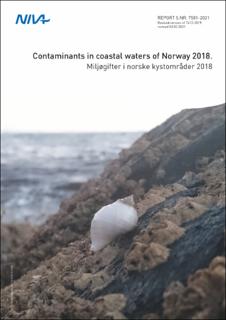Contaminants in coastal waters of Norway 2018
Green, Norman W.; Schøyen, Merete; Hjermann, Dag Ø.; Øxnevad, Sigurd; Ruus, Anders; Beylich, Bjørnar; Lund, Espen; Tveiten, Lise; Jenssen, Marthe T. S.; Håvardstun, Jarle; Ribeiro, Anne Louise; Doyer, Isabel; Rundberget, Jan Thomas; Bæk, Kine
Research report
Published version
Permanent lenke
http://hdl.handle.net/11250/2635080Utgivelsesdato
2021Metadata
Vis full innførselSamlinger
- NIVA-rapporter [6990]
Sammendrag
This programme examines the levels, trends and effects of contaminants in biota along the coast of Norway. The 2018-investigation included analyses of more than 133 different contaminants or biological effect parameters in five species (blue mussel, dogwhelk, common periwinkle, cod and the common eider). The contaminants include metals (Hg, Cd, Pb, Cu, Zn, Ag, As, Ni, Cr and Co), tributyltin (TBT), organochlorines (e.g. PCBs (PCB-7), DDT), PAHs, polybrominated diphenyl ethers (PBDEs), and perfluorinated alkylated substances (PFAS), as well as contaminants that have recently received much attention such as hexabromocyclododecane (HBCDs), chlorinated paraffins (SCCP, MCCP), bisphenol A (BPA), tetrabrombisphenol A (TBBPA), alkyphenols, siloxanes (D4, D5 and D6) and dechlorane plus. Biological effects parameters included VDSI, OH-pyrene metabolites, ALA-D and EROD. In the report, 30 representative substances or parameters were chosen for analyses of 713 time series (last 10 years). Of these there were statistically significant trends in 102 cases: 79 were downwards and 23 upwards. The upward trends were also associated with metals (78.3 %), primarily Hg (17.4 %).The dominance of downward trends indicated that contamination is decreasing for the measured substances. The downwards trends for TBT-concentrations and effect parameter (VDSI) confirmed that the legislation banning the use of TBT has been effective. Of the 2018-medians (last year) for all 713 time series, there were 323 cases that could be classified against EQS, of which 203 (62.8 %) were below the EQS and 120 (37.2 %) were above the EQS. Of the 2018-medians for the 713 time series, 641 cases could be classified using Norwegian provisional high reference contaminant concentrations (PROREF). Of these, 463 were below PROREF and 173 exceeded PROREF: 117 by a factor of less than two, 45 by a factor between two and five, eight by a factor between five and 10, four by a factor between 10 and 20, and four by a factor greater than 20. Some cases warrant special concern, such as high concentrations of several organic contaminants in cod liver from the Inner Oslofjord. High concentrations of DDE in mussels from the Sørfjord were related to earlier use of DDT as pesticide in orchards along the fjord. Concentrations of an expanded list of PFAS in cod liver from the Inner Oslofjord sampled since 1990 are presented. Results of analyses of stable isotopes of carbon and nitrogen are presented to investigate the role of food origin and trophic levels for observed contaminant concentrations.
Beskrivelse
Revised version of 7412-2019 / M-1515
Utgiver
Norsk institutt for vannforskningSerie
NIVA-rapport;7581Miljødirektoratet-rapport;M-1937

